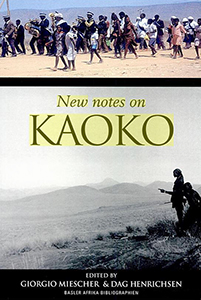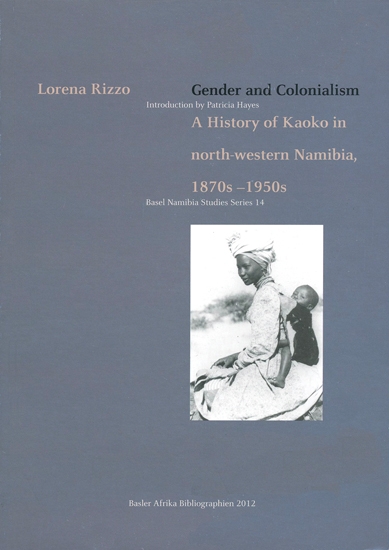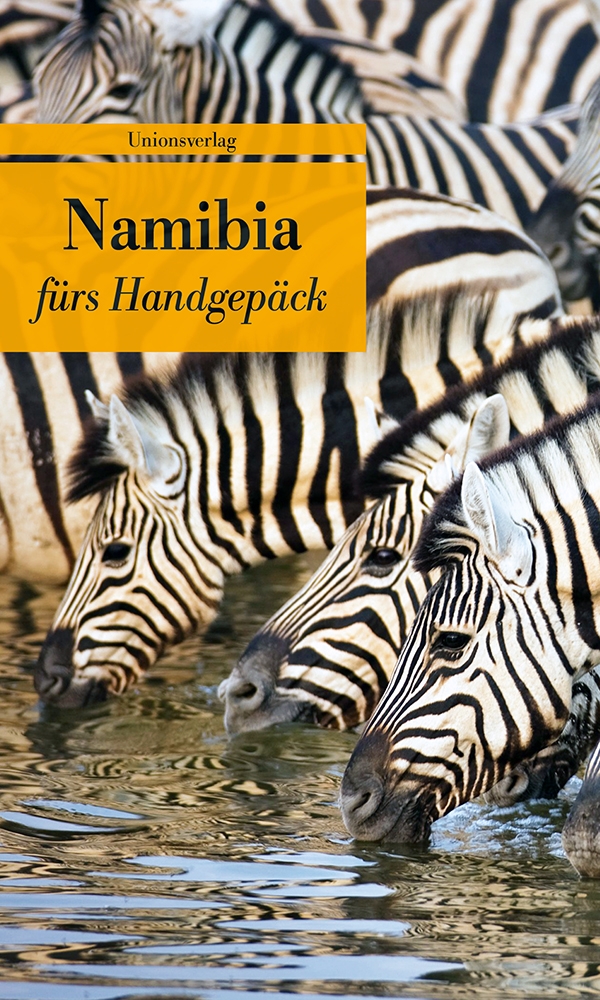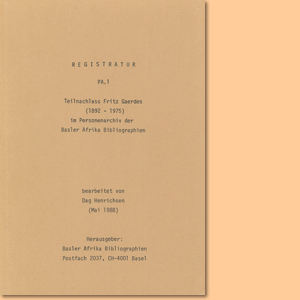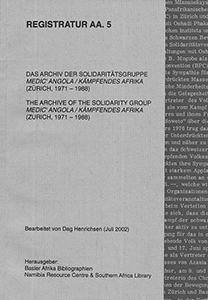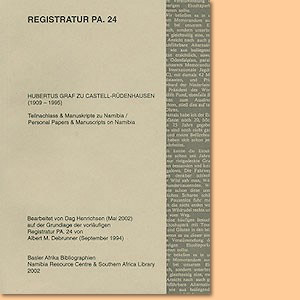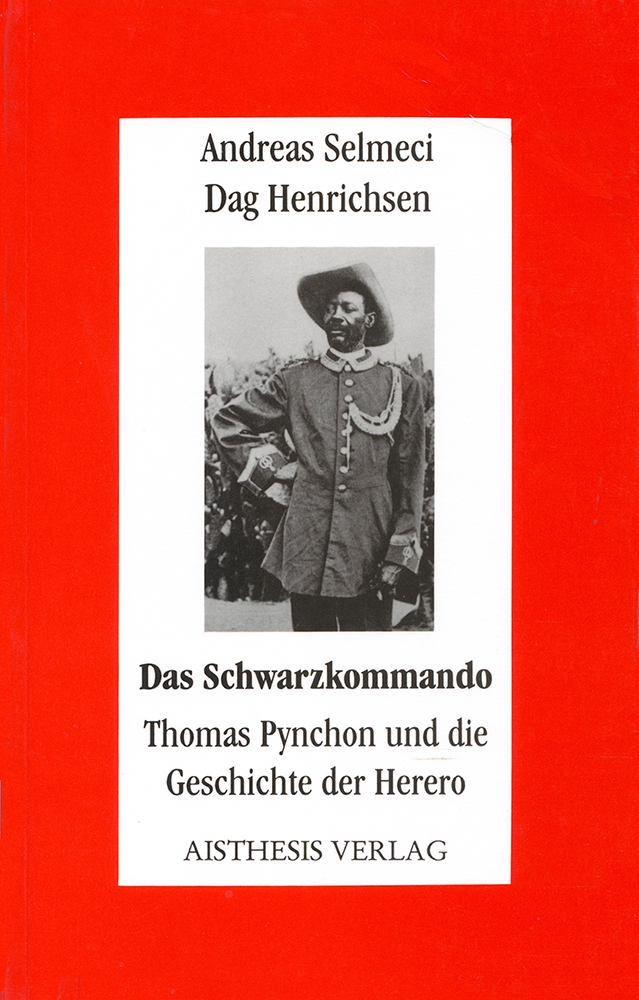New Notes on Kaoko, by Giorgio Miescher and Dag Henrichsen

New Notes on Kaoko: Giorgio Miescher, Dag Henrichsen, Lorena Rizzo et al.; Basler Afrika Bibliographien. Basel, 2000. ISBN 3905141744 / ISBN 3-905141-74-4

New Notes on Kaoko, by Giorgio Miescher and Dag Henrichsen.
The essays in New Notes on Kaoko are written by authors living either in Kaoko and being teachers, community activists, journalists or entrepreneurs, and authors living elsewhere within or outside Namibia and being historians, linguists, anthropologists or geographers. Their contributions are a result of a call for papers, intitiated by Giorgio Miescher and Dag Henrichsen.
Dag Henrichsen Lorena Rizzo Giorgio Miescher
Kaoko, the northern part of the Kunene Region in north-western Namibia, has become the focus of a rapidly growing number of publications world-wide: lavishly illustrated coffee-table books, glossy travel guides and tourist magazines, thick academic theses and even thicker socio-economic feasibility studies. When browsing through these publications two themes emerge: Kaoko, ‘the land of unspoiled nature’, and Kaoko, ‘the home of the Himba, nomads of Namibia’. Titles such as The Last Wilderness and Sensual Africa reflect perceptions of Kaoko as a mysterious and exceptional place, a space onto which urbanised elites are able to project ideas of a ‘pure’ nature and ‘exotic natural life’. Kaoko has become a myth, not only for Namibian leisure seekers, international tourist companies and acclaimed photographers, but also, it seems, for Namibian politicians, overseas anthropologists, ‘indigenous peoples’ activists and publishers. Many perceive Kaoko as being ‘in danger’: due to the proposed hydroelectric power scheme at Epupa, on the Kunene river, which forms the northern border of the Kunene Region; due to a fast growing tourist industry in Namibia which offers four-wheel drive and fly-in adventure safaris into Kaoko; and due to the modernity of urban life in Opuwo, the administrative and economic centre of Kaoko, and the increasing local consumption of the spoils of a global material mass culture. Until Namibia’s independence in 1990, the South African colonial administration restricted passage into and out of the region, and limited development. The area was called Kaokofeld, Kaokoveld or, with the creation of an apartheid homeland by the administration in 1970, Kaokoland. These terms referred to administrative units which differed in status and size over time. Local residents today use the term Kaoko, which refers to the pre-colonial Okaoko region. As ‘Kaoko’ is not congruent with any, clearly defined, political or geographical space nor with former colonial entities, ‘Kaoko’ suggests a break with the colonial pasts and it is for this reason that we have decided to use it in this book. The present volume does not seek ‘pure nomads’ and a ‘pure nature’, but seeks a modern Kaoko. It presents essays about the diverse pasts and current lives and experiences of its people. Triggered by an increasing irritation with the published staple products on Kaoko, this book calls for a move away from the limitations of the dominant discourses on Kaoko and offers heterogeneous perspectives from and on Kaoko. In particular, it includes perspectives from contributors residing in Kaoko, views which are ignored in much of the literature on Kaoko. In our proposal we reflected on the myth of Kaoko and noted that "the most influential book on Kaoko is Notes on the Kaokoveld (S. W.A.) and it’s People by the South African Government Ethnologist N.J. van Warmelo, published first in 1951. Ever since, writers about Kaoko rely on this book. We would like to publish new and different notes on Kaoko." In the call for papers we asked for essays on the history of and daily life in Opuwo, Sesfontein or Okonguati. We suggested the need to know more about the changes and possibilities that Namibia’s independence had created in Kaoko. We asked about any new political parties and interest groups that had been formed since 1990, about the manner in which relations with the Angolan border region had changed, and about what had happened to the Kaoko soldiers of the 1980s. We posed questions of how people from Kaoko experience life in Windhoek or Walvis Bay and how fellow Namibians living in Oshakati or Keetmanshoop view Kaoko. In the proposal we pointed out that "we are not interested in essays on Kaoko which project the dreams and images of an urbanised audience like that of Windhoek, Frankfurt or New York." […]
This is an extract from the book: New Notes on Kaoko, by Giorgio Miescher and Dag Henrichsen.
Title: New Notes on Kaoko
Editors: Giorgio Miescher; Dag Henrichsen;
Basler Afrika Bibliographien
Basel, 2000
ISBN 3905141744 / ISBN 3-905141-74-4
Softcover, 17 x 24 cm, 310 pages, 80 photographs, drawings, maps
Miescher, Giorgio und Henrichsen, Dag und Rizzo, Lorena im Namibiana-Buchangebot
New Notes on Kaoko
'New Notes on Kaoko' questions the myth of Kaoko, an image of the region as isolated and exotic, through written texts and also through an examination of photographs.
Gender and Colonialism: A History of Kaoko in North-Western Namibia 1870s-1950s
Gender and Colonialism: A History of Kaoko in North-Western Namibia 1870s-1950s is an attempt to convey a multi-faceted history of a region that has only recently been tied into a national historiography.
Koloniale Vergangenheit – Postkoloniale Zukunft? Die deutsch-namibischen Beziehungen neu denken
Koloniale Vergangenheit – Postkoloniale Zukunft? Die deutsch-namibischen Beziehungen neu denken. Beiträge zur Komplexität von Erinnerungskultur, Verantwortungsübernahme und gesellschaftlichen Ungleichheiten.
Lewis Nkosi. The Black Psychiatrist / Flying Home
Lewis Nkosi: The Black Psychiatrist / Flying Home is dedicated to the astounding South African writer and literary critic Lewis Nkosi (1936–2010).
Namibia fürs Handgepäck
Südafrika fürs Handgepäck ist eine Sammlung von Auszügen aus Klassikern der südafrikanischen Literatur.
Re-Viewing Resistance in Namibian History
Re-Viewing Resistance in Namibian History brings together the output of experienced academics and a new wave of Namibian historians.
Bruchstücke. Forschungsreisen in Deutsch-Südwestafrika
Bruchstücke ist eine Sammlung von Briefen des Schweizer Hans Schinz von seinen Forschungsreisen in Deutsch-Südwestafrika.
Teilnachlass Fritz Gaerdes (1892-1975) im Personenarchiv der Basler Afrika Bibliographien
Der Teilnachlass von Fritz Gaerdes ist unter der Registratur PA1 bei den Basler Afrika Bibliographien geordnet.
Herrschaft und Alltag im vorkolonialen Zentralnamibia. Das Herero- und Damaraland im 19. Jahrhundert
Herrschaft und Alltag im vorkolonialen Zentralnamibia. Ein Studie über die Geschichte des Herero- und Damaraland im 19. Jahrhundert.
Altlasten. Namibias langer Weg in die Unabhängigkeit
Die 300. Ausgabe mit einem hochinteressanten Namibia-Themenschwerpunkt über die politischen Altlasten und Namibias Weg in die Unabhängigkeit.
Das Archiv der Solidaritätsgruppe Medic' Angola / kämpfendes afrika
Einer Erschliessung der umfangreichen Archivsammlung der Basler Afrika Bibliographien der 1988 aufgelösten "Solidaritätsgruppe Medic' Angola / kämpfendes afrika".
Hubertus Graf zu Castell-Rüdenhausen 1909–1995
Dies ist die Registratur PA.24 des Teilnachlasses und der in Namibia verfertigten Manuskripte von Hubertus Graf zu Castell-Rüdenhausen 1909–1995.
Völkermord in Deutsch-Südwestafrika
Die Beitragssammlung Völkermord in Deutsch-Südwestafrika stellt die Ansichten verschiedener Autoren zum Herero- und Namaaufstand in dar.
Teilnachlaß Ernst Rudolf und Anneliese Scherz
Der Teilnachlaß Ernst Rudolf Scherz und Anneliese Scherz befindet sich im Personenarchiv der Basler Afrika Bibliographien.
Das Schwarzkommando. Thomas Pynchon und die Geschichte der Herero
Das Schwarzkommando. Thomas Pynchon und die Geschichte der Herero. Eine Studie über Pynchons Romanbezug auf ein Geschichtsbild der Herero.
Usakos: Photographs Beyond Ruins
The photographic collection "Usakos: Photographs Beyond Ruins" consists of images taken from albums of old location inhabitants of the 1920s-1960s.
Die Rote Linie. Geschichte der Veterinär- und Siedlungsgrenze in Namibia, 1890er-1960er Jahre
Auf Grundlage der Dissertation über "Die Rote Linie. Eine Geschichte der innernamibischen Polizei-, Siedlungs- und Veterinärgrenze" von 2009.
Posters in Action. Visuality in the Making of an African Nation
Posters in Action is a rich illustrated volume on the making of an African Nation and analyses and documents historically the impact of posters on Namibia.
African posters. A catalogue of the poster collection in the Basler Afrika Bibliographien
The catalogue of African posters collection is one of several special collections in the Basler Afrika Bibliographien.

